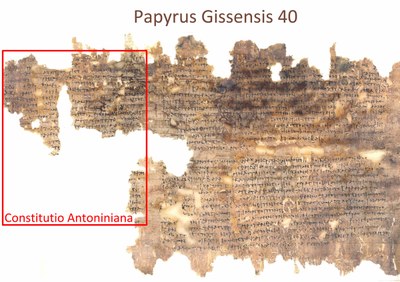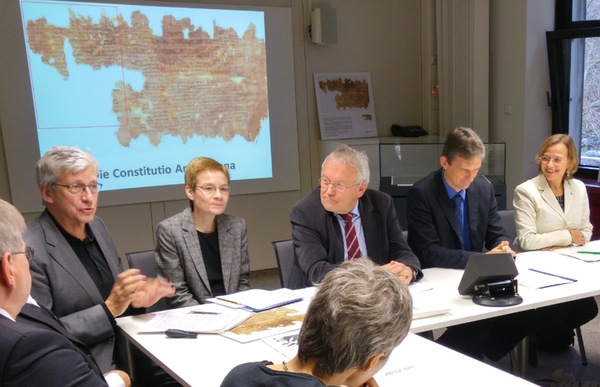Known History of the Constitutio Antoniniana
This page describes the known history of the Constitutio Antoniniana, from the promulgation of the edict to the inscription of the papyrus document on UNESCO’s Memory of the World Register.
212/213: Promulgation of the Constitutio Antoniniana edict
Roman Emperor Caracalla issued the Constitutio Antoniniana edict, granting Roman citizenship to nearly all free inhabitants of the Roman Empire.
215: Writing on the papyrus

The period prior to the rediscovery of the papyrus
It is not clear what happened to the papyrus after 215, although it was probably originally from Heptacomia in Egypt. It was acquired in El Ashmunein, Egypt.
Around 1901, Ernst Kornemann (1868–1946), a classical historian from Giessen, proposed the creation of a papyrus collection for teaching and research purposes. He procured the support of private patrons, including the Giessen industrialist Wilhelm Gail (1854–1925), to finance the project.
1902: Acquisition
In 1902, Kornemann acquired the first 150 papyri from a merchant, quite unaware that the Constitutio Antoniniana was among them.
The site where the papyrus with the Constitutio Antoniniana edict was found was probably the ancient town of Hermopolis Magna in Egypt, near the contemporary town of El Ashmunein.
The papyri were first placed in the Museum des Oberhessischen Geschichtsvereins (Museum of the Historical Society for Upper Hessia), which was soon housed in the Altes Schloss (Old Castle) of Giessen. Later, further acquisitions were made to enlarge the collection.
Today the Constitutio Antoniniana papyrus is in the possession of the university city of Giessen (Oberhessisches Museum).
Between 1902 and 1910: the first restoration
Hugo Ibscher, the foremost restorer of papyrus at the time, undertook the first restoration of the Constitutio Antoniniana in Berlin. The papyrus was completely cleaned, backed with a layer of paper, and then enclosed between glass plates.
During World War II, the Oberhessisches Museum in the Altes Schloss in Giessen burned to the ground following a bombing raid in December 1944. The complete correspondence pertaining to the papyrus collection that had been stored in Giessen, which might have provided us with more detailed information, was destroyed.
1910: First publication by Paul Meyer
Die Bedeutung des Papyrus mit der Constitutio Antoniniana wurde recht früh erkannt und 1910 von Paul Meyer (Berlin, 1865-1932) als "Papyrus Gissensis 40" publiziert, also transkribiert, übersetzt und kommentiert.
1930: Move to the university library
The Papyri Gissenses with the Constitutio Antoniniana were transferred to the university library on Bismarckstrasse as a permanent loan in 1930 to make the documents more accessible for research and teaching. This move ultimately saved the Constitutio Antoniniana from destruction. In November 1939, all papyrus collections were moved to the basement of the library for their protection.
1940: Storage in the Dresdner Bank’s basement vault
To protect it from bombing raids, the Papyrus Gissensis 40 was stored in a basement vault at the Dresdner Bank in 1940, directly across from the Johanneskirche in Giessen.
February 1945: flooding
Due to flooding of the Wieseck River in February 1945, the level of groundwater in Giessen rose and the bank vault was flooded; water seeped in between the glass plates protecting the papyrus.
This damage was not discovered until February 1946, when a member of the library staff inspected the vault. By then Constitutio Antoniniana had been damaged by decomposition and mold, and the glass plate had cracked.
Spring of 1946: Retrieval
The papyri could not be retrieved and brought back to the ruins of the university library building, which had also been destroyed in December 1944, until the spring of 1946.
In 1946/47, the plates were opened and the documents cleaned, dried, and reglazed in the library’s own book bindery. This procedure was not entirely successful for the Constitutio Antoniniana. Only a second papyrus that was on the reverse side of the Constitutio Antoniniana papyrus and under the same glass panel could be successfully detached. The Constitutio Antoniniana papyrus could not be detached from the cracked front glass plate or from the paper laid under its reverse side decades earlier. The dark mold spots and color changes visible on the papyrus today date from this time. Some smaller fragments were lost.
1958: New library building at the old location
In 1958, the collections were stored in the papyrus room of the new library building constructed on the site of the old library. This building was opened in July 1959.
1984: New library building on the Philosophikum I campus
The Constitutio Antoniniana and the papyrus collection found a new home in the new university library, which was completed in 1984 on the humanities campus (Philosophikum I); this is where they are still stored today.
2009: Restoration in Leipzig
Thanks to financial support from the non-profit foundation of the Sparkasse Giessen (Gemeinnützige Stiftung der Sparkasse Gießen), the Constitutio Antoniniana was reglazed in the restoration workshop of Leipzig University’s papyrus collection in 2009, an undertaking that sparked considerable public interest (see Recke/Schneider 2009).
2017: Inscription in the UNESCO Memory of the World Register
Late in October 2017, an international committee of experts meeting in Paris made the decision to inscribe the Constitutio Antoniniana papyrus on the UNESCO Memory of the World Register.

Press conference and presentation on 6 December 2017, photograph by Frank Waldschmidt-Dietz [CC BY-SA 4.0]. From left: Dr. Peter Reuter (library director), Prof. Karen Piepenbrink (professor of ancient history), Prof. Joachim-Felix Leonhard (German UNESCO Committee), Prof. Peter Winker (vice president, Justus Liebig University Giessen), Dietlind Grabe-Bolz (mayor of Giessen)
You will find information on how papyrus is made in the >>next section<<.